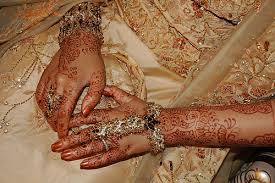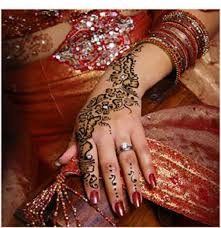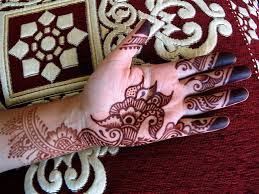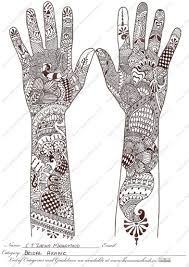Simple Mehandi Design Biography
The henna plant is native to northern Africa, western and southern Asia, and northern Australasia, in semi-arid zones and tropical areas.[2][6] It produces the most dye when grown in temperatures between 35 and 45 °C (95 and 113 °F).[7] During the onset of precipitation intervals, the plant grows rapidly, putting out new shoots. Growth subsequently slows. The leaves gradually yellow and fall during prolonged dry or cool intervals. It does not thrive where minimum temperatures are below 11 °C .Henna was used for cosmetic purposes in Ancient Egypt, as well as other parts of North Africa, West Africa, the Horn of Africa, the Arabian Peninsula, the Near East and South Asia. It was also popular among women in Iberia and 19th-century Europe. Today, bridal henna nights remain an important tradition in many of these areas.
The paste can be applied with many traditional and innovative tools, including resist, a cone, syringe, Jac bottle or fingers. A light stain may be achieved within minutes, the longer the paste is left on the skin, the stronger the stain will be, and should be left for several hours. To prevent it from drying or falling off the skin, the paste is often sealed down by dabbing a sugar/lemon mix over the dried paste, or simply adding some form of sugar to the paste. It is debatable whether this adds to the color of the end result; some believe it increases the intensity of the shade. After time the dry paste is simply brushed or scraped away.
Henna stains are orange soon after application, but darken over the following three days to a reddish brown. Soles and palms have the thickest layer of skin and so take up the most lawsone, and take it to the greatest depth, so that hands and feet will have the darkest and most long-lasting stains. Steaming or warming the henna pattern will darken the stain, either during the time the paste is still on the skin, or after the paste has been removed. Chlorinated water and soaps may spoil the darkening process: alkaline products may hasten the darkening process. After the stain reaches its peak color it will appear to fade, as the stained dead cells exfoliates.








The henna plant is native to northern Africa, western and southern Asia, and northern Australasia, in semi-arid zones and tropical areas.[2][6] It produces the most dye when grown in temperatures between 35 and 45 °C (95 and 113 °F).[7] During the onset of precipitation intervals, the plant grows rapidly, putting out new shoots. Growth subsequently slows. The leaves gradually yellow and fall during prolonged dry or cool intervals. It does not thrive where minimum temperatures are below 11 °C .Henna was used for cosmetic purposes in Ancient Egypt, as well as other parts of North Africa, West Africa, the Horn of Africa, the Arabian Peninsula, the Near East and South Asia. It was also popular among women in Iberia and 19th-century Europe. Today, bridal henna nights remain an important tradition in many of these areas.
The paste can be applied with many traditional and innovative tools, including resist, a cone, syringe, Jac bottle or fingers. A light stain may be achieved within minutes, the longer the paste is left on the skin, the stronger the stain will be, and should be left for several hours. To prevent it from drying or falling off the skin, the paste is often sealed down by dabbing a sugar/lemon mix over the dried paste, or simply adding some form of sugar to the paste. It is debatable whether this adds to the color of the end result; some believe it increases the intensity of the shade. After time the dry paste is simply brushed or scraped away.
Henna stains are orange soon after application, but darken over the following three days to a reddish brown. Soles and palms have the thickest layer of skin and so take up the most lawsone, and take it to the greatest depth, so that hands and feet will have the darkest and most long-lasting stains. Steaming or warming the henna pattern will darken the stain, either during the time the paste is still on the skin, or after the paste has been removed. Chlorinated water and soaps may spoil the darkening process: alkaline products may hasten the darkening process. After the stain reaches its peak color it will appear to fade, as the stained dead cells exfoliates.
Simple Mehandi Design
Simple Mehandi Design
Simple Mehandi Design
Simple Mehandi Design
Simple Mehandi Design
Simple Mehandi Design
Simple Mehandi Design
Simple Mehandi Design
Simple Mehandi Design
No comments:
Post a Comment